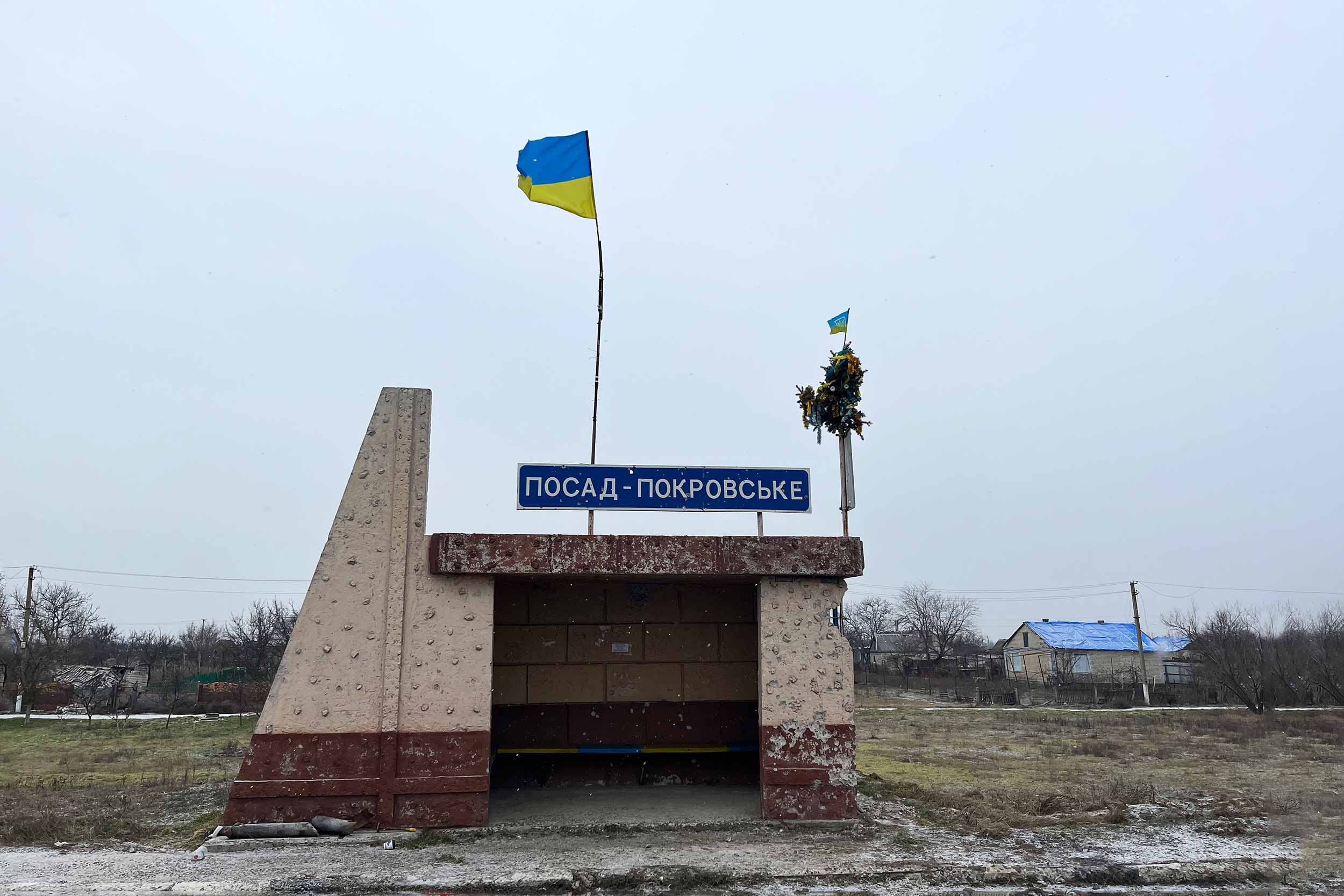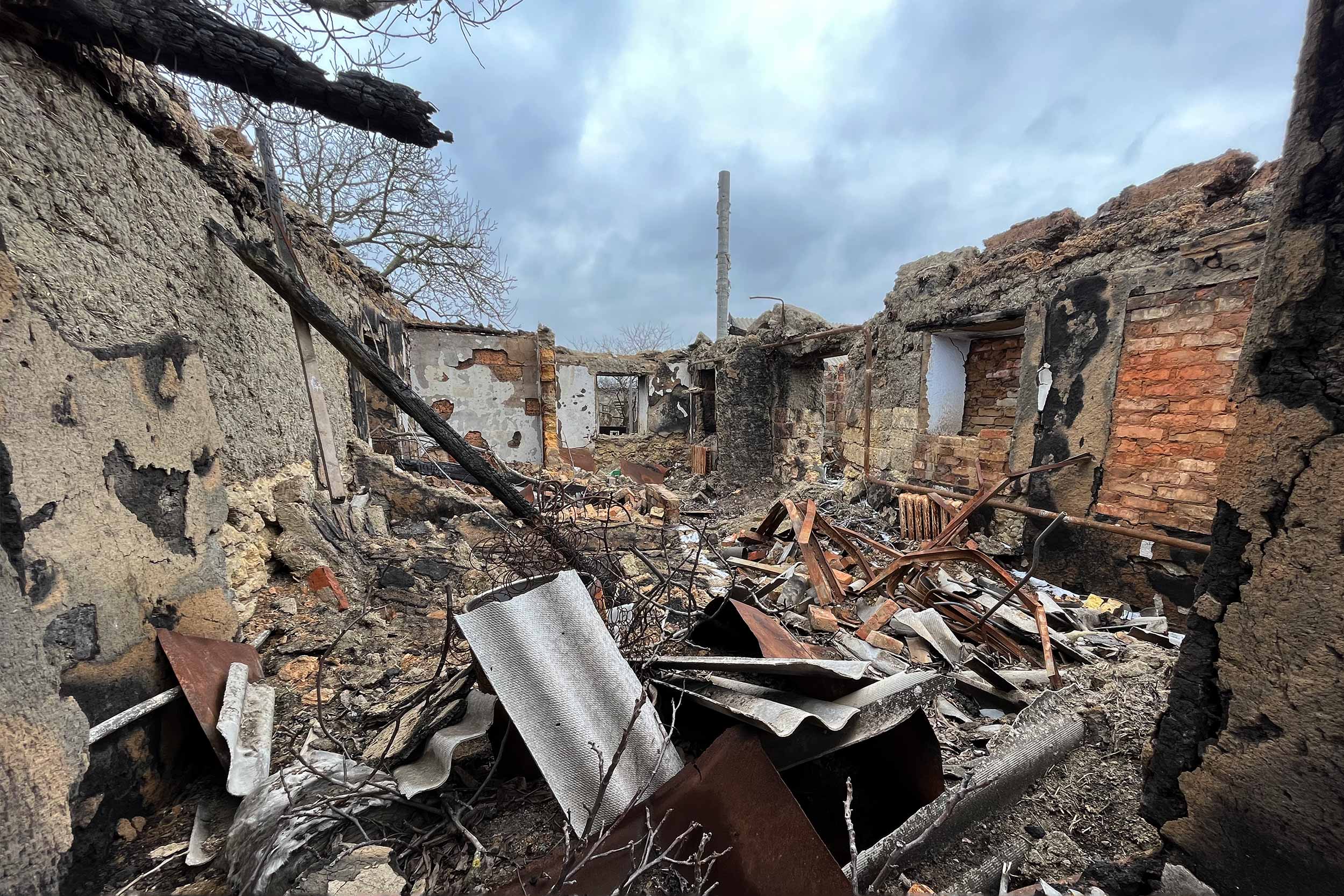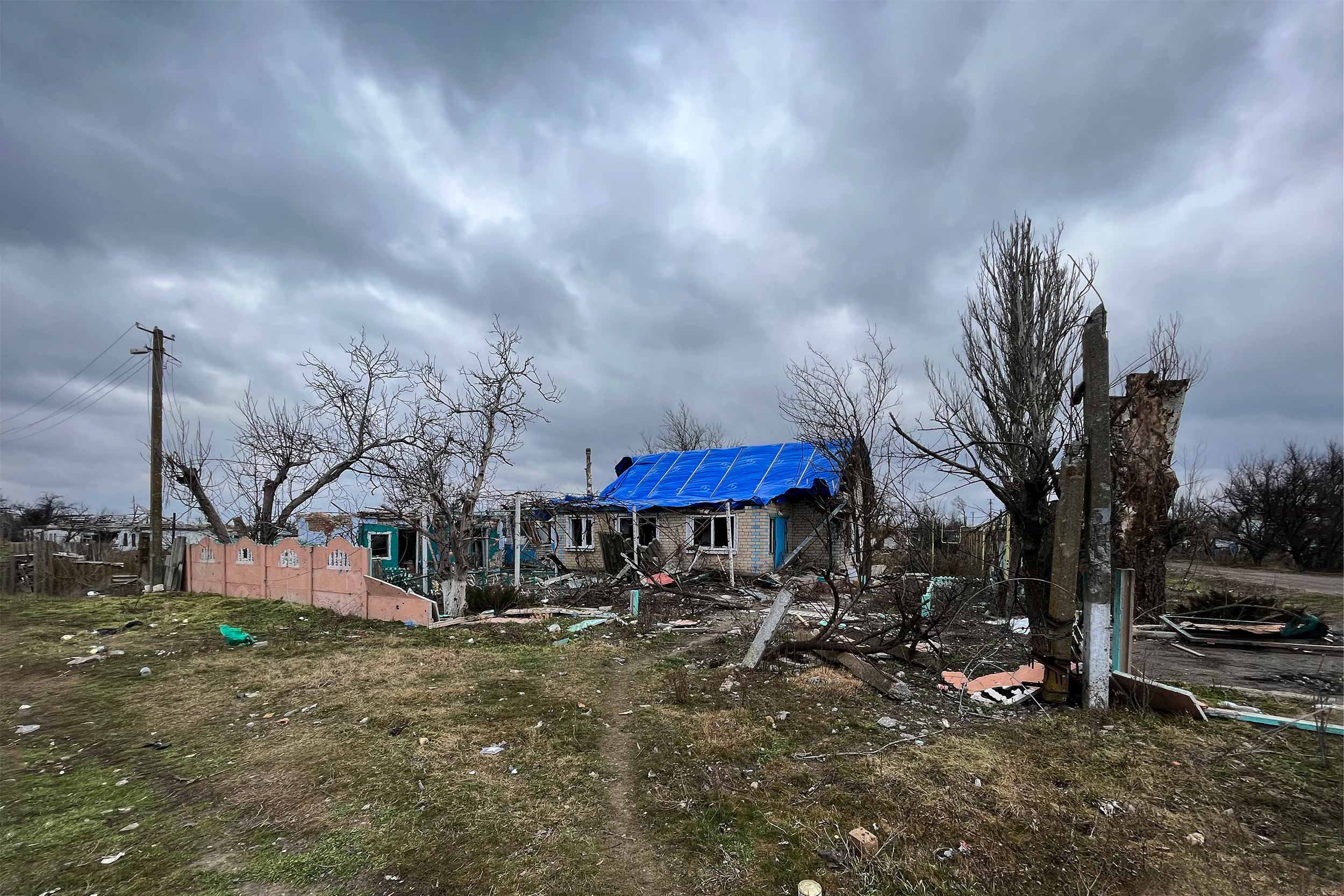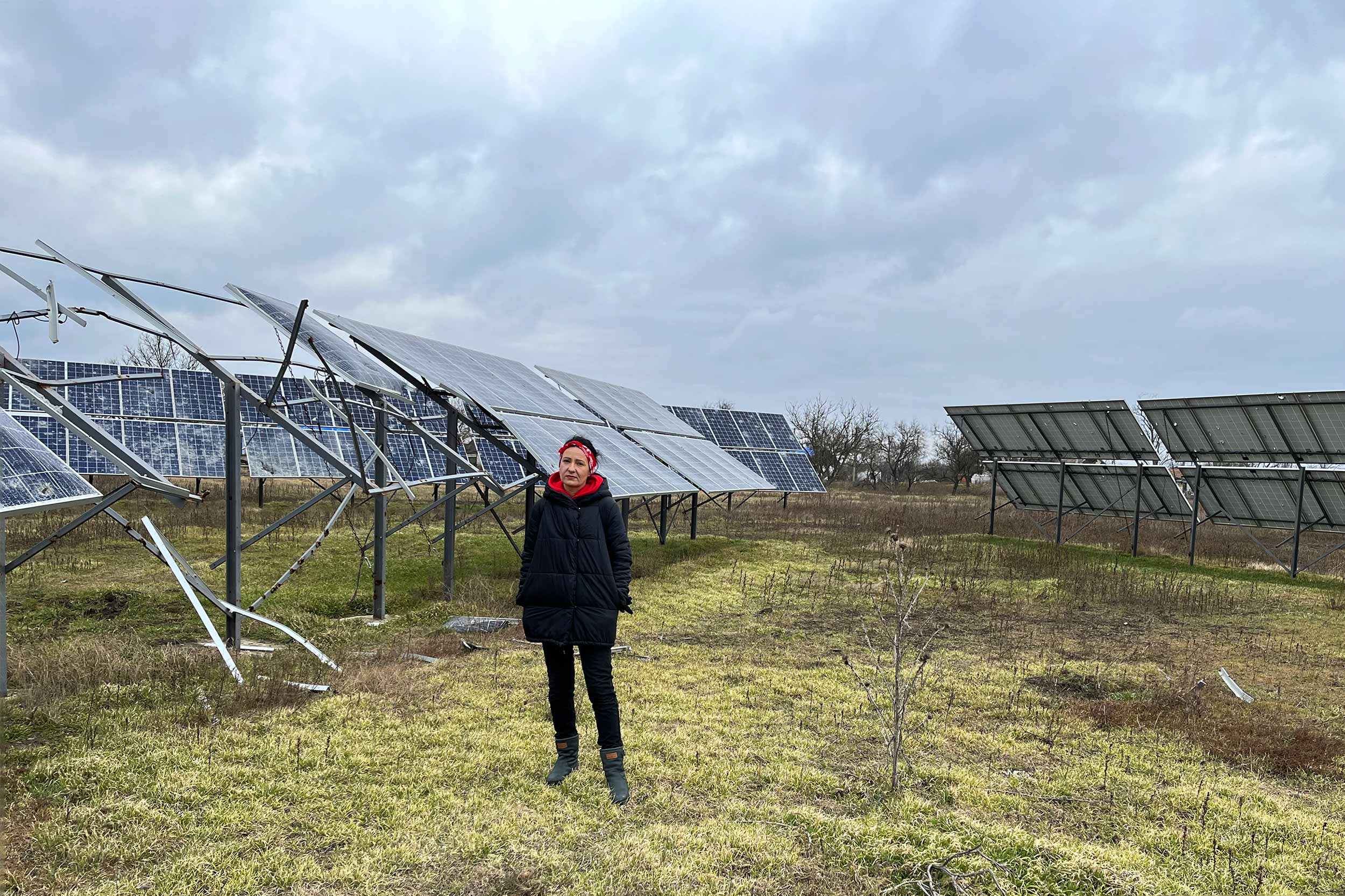Posad-Pokrovs’ke: “We Need a Whole New Village”
The strategic southern settlement destroyed by shelling faces a daunting task as it looks to recover.
Posad-Pokrovs’ke: “We Need a Whole New Village”
The strategic southern settlement destroyed by shelling faces a daunting task as it looks to recover.
Lyudmila Yalovenko recalled how she fled her home in the southern village of Posad-Pokrovs’ke under heavy Russian fire. She, her husband, parents, ten dogs and two cats were all crammed into one car.
“We were being shot and shelled during our evacuation,” Yalovenko, 41, continued, describing how the car doors fell off as the vehicle was moving.
“But I’m positive now because, really, I have nothing to lose anymore,” she said.
Three months after the Russian collapse in Kherson, towns and villages in the area are beginning to look beyond a harsh first year of war. But residents are daunted by the scale of the challenge and haunted by echoes of the trauma.

The situation is encapsulated in this devastated settlement, at the regional border, halfway between Kherson and Mykolaiv.
Posad-Pokrovs’ke became a key strategic front in the defence of Mykolaiv and in the fightback to liberate Kherson. But relentless Russian shelling left 90 per cent of its 940 houses severely damaged or destroyed, and residents can hardly imagine how to recover.
“Truly speaking, we do not need building materials,” said Larisa Sokolova, deputy head of Posad-Pokrovs’ke. “We need a whole new village.”
The settlement is acknowledged for the critical role it played in repelling the Russian onslaught.
“From the very beginning, we understood that this village will be sacrificed for the safety of others, because of its very good position, directly across from the base used by the Russians,” Yalovenko recalled.

In the first days of March, residents alerted the Ukrainian army about several enemy tanks that had stalled there, and then proceeded to dismantle them themselves within hours.
“They did what they could to prevent Russians from taking these tanks back to their base,” said General Dmytro Marchenko, who was then commander of the Mykolaiv defence.
The locals also informed the army about Russian troops hiding in underground water channels just outside the village, Marchenko continued, allowing Ukrainian forces to launch pre-emptive strikes.
“We used to go onto the roof and watch them with binoculars – how they were trying to go around the village on one side or the other,” recalled Yalovenko.
After Ukrainian forces pushed the Russians out, they themselves occupied water channels and other positions at the end of the settlement.
The Russian response, for eight months, was to rain down 80 or more shells a day on the village.
“Our military took up positions at this border,” said the general. “So as the Russians tried to beat us away from there, they destroyed the village.”
The evidence is everywhere, with the modest houses in ruins up and down the few broad streets. Blue tarps bearing humanitarian logos have been lashed onto many houses to cover damaged or absent roofs.

The numerous holes cratered into the road have been filled with rocks and debris to make passage a little easier.
Yalovenko, a dog breeder, recalls when the first shell fell in their yard. At the incoming whistle, her husband pushed her to the corner and covered her with his body, as shrapnel came through the window, leaving marks on the walls.
One shell caused a fire in their house, which they managed to extinguish. The nearby house of Yalovenko’s parents was completely destroyed.
“The Russians were about three kilometres away, and they were shelling so heavily that during the few days we spent here under shelling, I had to crawl on my knees to go to the bathroom and we had to use a bucket,” she said.
Soon, almost all but 20 or so of the village’s 2,300 residents had fled. Given the extent of bombardment, residents understood that after they left, everything they had would be destroyed. But it was still a shock to return.
“We were crying for half a year,” said Yalovenko. “And when I saw the house for the first time, I couldn’t speak for three days.”
She and her farmer husband counted at least ten hits on their property. With missile shards still littering the lawn, the house was no more than a shell.
“In the beginning, I could see the wallpaper, the furniture, the children’s room and armchair, everything we’ve been working for for 20 years,” she said.
After a couple of months’ exposure to the elements, the interior settled into an indistinguishable rubble, almost making it easier to bear. “Now I have accepted it,” she said.
“Spring will come and we are going to start to rebuild. We’re going to start our life from scratch,” Yalovenko continued.
Their life investment, however is lost forever – the three banks of slanted solar panels that once stood in a small field behind their house. Costing 30,000 US dollars, this was their future dream for them and their children. Now the twisted and perforated panels stand useless and irreparable.

VOLUNTEER SPIRIT
On a cold, blustery day in the centre of the village, people huddled in a so-called invincibility point for internet and some warmth. In the corner, Ukrainian officials gave pronouncements on the war on a TV no one was watching.
“There is no centralised water, heating, gas or electricity supply over the whole village,” said deputy head Sokolova. “Shops are not working, nothing is working.”
Volunteer groups provide food and other supplies, from bread and beans to ready-made dinners. She herself heads up a small aid office in the village centre, where stacks of plywood and timber from the Red Cross lay available to residents trying to repair their homes.
Sokolova estimated that around 270 people had returned. A contract had been agreed to rebuild the clinic, but she did not seem optimistic about seeing results anytime soon.
“I don’t even know what we suffered for,” she continued, tears in her eyes. “Actually, I cannot see our village rebuilding without first demolishing all the houses here, because they are seriously damaged.”
Two streets away, a crew of eight in fluorescent orange vests, volunteers with the Ukrainian charity Dobrobat from recently liberated Kherson, set to work with no more than enthusiasm and rudimentary tools.
Their task was to clear up the debris and damaged or derelict outbuildings of a house that had belonged to the parents of Tatyana Chygryn. A blue tarp had already been affixed to the roof.

“My parents did not want to leave until the last moment,” the 51-year-old said. “But when a shell hit the kitchen, they did.
“Everything they had saved for was here,” she continued. “It was terrible for them. They were forced to evacuate to relatives in Cherkasy. Our father could not handle it, and on May 27, he died.”
The smashed roof of an outbuilding is tugged down, debris is shovelled away, broken timber cleared, while someone’s smartphone plays Ukrainian tunes.
Most of the team have no experience in construction, but this gives them a chance to get away from the continuing shelling in Kherson, and they find it fulfilling to help others.
“Ukrainian people are amazing because we can’t just sit and wait till the war ends, we have to do something,” said volunteer Larysa Bortovyk, 31, who ran a concert hall before the war.
She said that shelling had woken her three times the night before at her home in Kherson, but that “when you hear that people are so motivated, you can’t stop”.
Rebuilding Posad-Pokrovs’ke will take time, effort and resources. Even where funding can be found, the Ukrainian construction process will be challenging, slowed by procurement issues, concerns about transparency and corruption, by the war.
Sokolova foresaw a long road ahead.
“I know that people will want to go home,” she said. “But what we need is victory. Until then, it’s just all daydreaming.”
Translation and additional reporting by Mykhaylo Shtekel.

